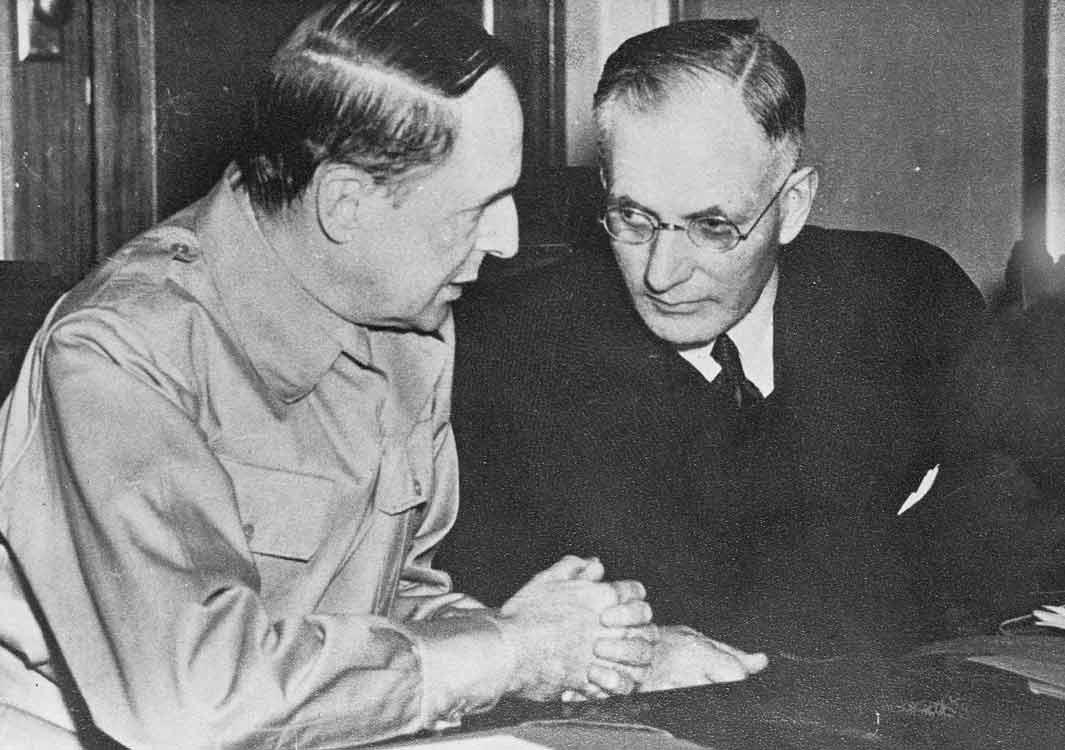
Prime Minister Scott Morrison’s White House visit crowns a sustained and disciplined execution of the MacArthur manoeuvre on President Donald Trump.
Employing the MacArthur method involves embracing the power of America while displaying enthusiasm for the man commanding it.
The manoeuvre is named after General Douglas MacArthur and Australia has been using it from the start. As Japanese forces threatened Australia and the alliance was born in the darkest moments of World War II, Canberra sought means to deal with its new great and powerful friend.
See the embrace and enthusiasm elements superbly combined in Prime Minister John Curtin’s letter advising MacArthur that he would command all Australian forces in the Pacific theatre.
You have come to Australia to lead a crusade, the result of which means everything to the future of the world and mankind. At the request of a sovereign State you are being placed in Supreme Command of its Navy, Army and Air Force, so that with those of your great nation, they may be welded into a homogeneous force and given that unified direction which is so vital for the achievement of victory.
Perfectly pitched for the American Caesar. MacArthur was a military genius with an ego to match, while Trump is a giant ego who thinks he’s a genius.
In his superb biography of Curtin, John Edwards says that tracing the relationship between the general and the prime minister ‘is complicated by MacArthur’s habitual grandiloquence and untruths’. The military supremo could be condescending and patronising and was a man of ‘vast self-regard’ (sound familiar?).
Curtin, though, ignored the slights, doing whatever was needed to establish a trusting relationship:
A lesser Australian leader might have grated against MacArthur’s vanity, cavilled at his assumption of command, contradicted his grandiloquent claims, satirised his manner. Curtin did not. He seized the chance to share authority with MacArthur, refused to offend his vanity, drew him as close as he could. Of Curtin’s military decisions, it was the cleverest, most fruitful, most abidingly successful. Like Churchill in his courtship of Roosevelt, Curtin would untiringly persist.
After the first explosive phone call between Trump and former PM Malcolm Turnbull, only days after the president’s inauguration, Australia flicked the switch to the full MacArthur.
Australia has tweaked the script. As always, massage the vanity. But where MacArthur could handle complexity, Trump needs a simple, up-beat message—no contradiction, no argument. The 45th president has been lavished with deference and acceptance that shades towards flattery and fawning.
Australia’s policy is deeply pragmatic: hold tight to what we’ve got, get what we can and don’t anger Trump. Loudly love the alliance. And if you can’t say anything nice about Trump, say nothing. Extra bits have been added to suit the Trump temper and temperament. We constantly remind the president that Australia has a trade deficit with America; he loves that US-wins-someone-else-loses stuff.
Australia’s tactic for dealing with Trump is the same as Japan’s (and Tokyo draws on its own deep experience of dealing with MacArthur as the supremo who personified the US). The manoeuvre has delivered a smoother ride for Oz than it has for Prime Minister Shinzo Abe.
The reward for Morrison is a state visit with all the trimmings.
Going the full MacArthur with Trump carries the risk that the tactic for massaging the individual warps larger strategic purposes: handling the US leader can become its own end, obscuring or even harming Australia’s interests.
Edwards writes that Curtin ‘saw the Pacific war too much through MacArthur’s eyes’, and in dealing with other governments Curtin became ‘a lobbyist for MacArthur’.
The trick for Morrison is to embrace Trump but not the Trump worldview; no easy feat when basking in the ceremonial hoopla Washington is so good at.
Australia has said a lot about the importance of the ‘rules-based global order’. Yet Canberra has been so soft as to be mute in speaking to Trump about his trade bonfires and the dangers of a protectionist, isolationist US.
The tactic was well put by Greg Sheridan in discussing the art of dealing with Trump:
Telling Trump to abandon his lifelong views on trade and the worthlessness of multilateral initiatives is pointless, but if you must do it, at least do it bilaterally, with his senior officials, behind closed doors. The best hope is Trump doesn’t notice the statement at all. If he does notice, Australia will have earned some hostility from him for no benefit. It’s the art of the deal.
The reality that Morrison must guard his words in speaking to Trump weighs against the personal warmth of the state dinner. That’s why Morrison’s most pointed words about international rules and trade were offered out of Trump’s presence, at the State Department lunch with Vice President Mike Pence.
Australia’s view of Trump and the US is a mixture of curiosity, attraction and doubt, according to New York Times Sydney bureau chief Damien Cave, who writes that his conversations with Australians about the US centre on this question: ‘Does aligning with the United States mean jumping into a car with an angry, vengeful driver more likely to crash, or joining forces with a still-powerful ally fighting for shared values and the preservation of a rules-based order?’
Steadfast ally versus Trump car crash is the conundrum beneath the Washington visit.
The point of the MacArthur manoeuvre is to embrace US power via enthusiasm for the man commanding the power. The magic in the method is to strike a balance between the power and the man, in the separate judgements needed about the state of the US and the personality of the president.